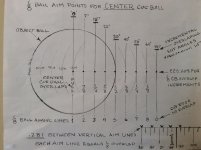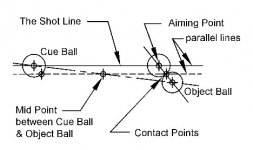You are using an out of date browser. It may not display this or other websites correctly.
You should upgrade or use an alternative browser.
You should upgrade or use an alternative browser.
I can’t see fraction hits (1/2ball, 1/4 ball etc.) how’d ya’ll go about training your
- Thread starter pmata814
- Start date
Create a straight in shot, mark the position of the balls.
Make the shot. Reset the balls. Move the CB one ball width to rt or left. Mark the new position of CB
Make the shot. Reset the balls. Move the CB one ball width in the same direction(now two ball widths off straight in.
Make the shot, continue the progression, you'll end at a super thin cut.
I look at even fractions of balls but I still need to envision the contact point and the ghost ball. I can't do it on fractions of balls alone.
Make the shot. Reset the balls. Move the CB one ball width to rt or left. Mark the new position of CB
Make the shot. Reset the balls. Move the CB one ball width in the same direction(now two ball widths off straight in.
Make the shot, continue the progression, you'll end at a super thin cut.
I look at even fractions of balls but I still need to envision the contact point and the ghost ball. I can't do it on fractions of balls alone.
.I aim by contact point. I just can’t see “fraction ball hits”. But i’m reading ‘The Beard’s’ book on banks and he teaches everything with fractions. How did you go about training your eyes to see them?

These are the 1/8 ball fractional points... The verticle lines would be for center CB.
Contact points are halfway between the OB center and where center CB is aimed.
.
Last edited:
FYI, several ways to visualize and practice them are illustrated and demonstrated on the fractional-ball aiming resource page.I aim by contact point. I just can’t see “fraction ball hits”. But i’m reading ‘The Beard’s’ book on banks and he teaches everything with fractions. How did you go about training your eyes to see them?
I hope something there helps,
Dave
I aim at contact point...stick with it and your brain will figure out curvatures of spheres, aiming at something that doesn't exist(ghost)...etc, and all that other busy brain stuff. I've played many, many amateurs and some pros in my competitive days that swore by their aiming systems, and I was happy to take their money too! 
Last edited:
Some useful tricks to help visualize the contact point are on the contact-point-to-contact-point and parallel-lines systems resource page. Also, a useful template for practicing ball-overlap, contact-point and cut angle visualization is available on the cut angle estimation resource page.I aim at contact point...stick with it and your brain will figure out curvatures of spheres, aiming at something that doesn't exist(ghost)...etc, and all that other busy brain stuff. I've played many, many amateurs and some pros in my competitive days that swore by their aiming systems, and I was happy to take their money too!
Enjoy,
Dave
To be clear, i dont intend to start shooting using fractions. I’m used to visualizing contact points. I just want to be able to recognize how it looks so i can be sure i’m reading/implementing The Beard’s book correctly.
Thank u for the replies.
Sent from my iPhone using Tapatalk
Thank u for the replies.
Sent from my iPhone using Tapatalk
One way you could do this is to make up triangles from paper that correspond to the various cut angles. For a 1/3 ball hit, for example, place the triangle so one side goes back to the cue ball from the center of the ghost ball and the other side points along the ghost ball/object ball line of centers. That will let you see the contact point for that hit. You only need to make up a few triangles.To be clear, i dont intend to start shooting using fractions. I’m used to visualizing contact points. I just want to be able to recognize how it looks so i can be sure i’m reading/implementing The Beard’s book correctly.
Thank u for the replies.
...
For additional help for banking, you could set up an target on a barstool along the right line to give yourself something to aim at after the paper triangle is removed.
buy poololgy
its not expensive and it will help you find the fractions
https://www.amazon.com/s/?ie=UTF8&k...qmt=e&hvbmt=be&hvdev=c&ref=pd_sl_5sief7emmb_e
its not expensive and it will help you find the fractions
https://www.amazon.com/s/?ie=UTF8&k...qmt=e&hvbmt=be&hvdev=c&ref=pd_sl_5sief7emmb_e
here is a long thread about it
caveat
the cte/pro 1 enthusiasts
were not as enthusiastic about it
http://forums.azbilliards.com/showthread.php?t=463689
caveat
the cte/pro 1 enthusiasts
were not as enthusiastic about it
http://forums.azbilliards.com/showthread.php?t=463689
Last edited:
Like you, I don't see fractions. Joe Tucker's Aiming by the Numbers was the answer for me. With the materials Joe provides, you can even practice the visualization away from the pool room, on your dining room table. It's a great product that really flies under the radar of the aiming system warfare.To be clear, i dont intend to start shooting using fractions. I’m used to visualizing contact points. I just want to be able to recognize how it looks so i can be sure i’m reading/implementing The Beard’s book correctly.
Thank u for the replies.
Sent from my iPhone using Tapatalk
Like you, I don't see fractions. Joe Tucker's Aiming by the Numbers was the answer for me. With the materials Joe provides, you can even practice the visualization away from the pool room, on your dining room table. It's a great product that really flies under the radar of the aiming system warfare.
Yea. I own his aiming by the numbers workbooks as well. I like all of tucker’s stuff. Therez several good suggestions here on fractional aiming. I plan to give them a try. Thx again for all the replies.
Sent from my iPhone using Tapatalk
I aim by contact point. I just can’t see “fraction ball hits”. But i’m reading ‘The Beard’s’ book on banks and he teaches everything with fractions. How did you go about training your eyes to see them?
Sent from my iPhone using Tapatalk
I never had any luck with fractional hits. I feel there are many many more places to hit the ball than fractional hits. I use Double the Distance sometimes, equal parts of object ball - cue ball hits & others. Works for me.....
Attachments
To be clear, i dont intend to start shooting using fractions. I’m used to visualizing contact points. I just want to be able to recognize how it looks so i can be sure i’m reading/implementing The Beard’s book correctly.
Thank u for the replies.
.
View attachment 482073
These are the 1/8 ball fractional points... The verticle lines would be for center CB.
Contact points are halfway between the OB center and where center CB is aimed.
The ball fractions that you want to be able to recognize how it looks are shown in the above attachment.
Think of 2 discs.. one disc passing the other.. As the front disc passes over the back disc, overlaps will decrease.
The CB overlap fractions are shown as light semicircles from the OB edge. 7/8 ball, 3/4 ball, 5/8 ball, and 1/2 ball.
As the CB center moves to the right in .281 increments the CB edge (1/8 ball fractions) moves an equal distance.
.
Last edited:
I never had any luck with fractional hits. I feel there are many many more places to hit the ball than fractional hits. I use Double the Distance sometimes, equal parts of object ball - cue ball hits & others. Works for me.....
Double the distance also works with fractions. The balls overlap forming a football shape.
The contact point is always in the center of that shape. If you know the distance from the
OB center to the contact point you double the distance. The contact point is between the
ball centers and is always halfway from the OB center and where the CB center is aimed.
.
I think your image best illustrates the midpoint parallel shift aiming system. FYI, I've added your image and a link to your post on the resource page.I never had any luck with fractional hits. I feel there are many many more places to hit the ball than fractional hits. I use Double the Distance sometimes, equal parts of object ball - cue ball hits & others. Works for me.....
For those interested in double the distance, it is illustrated and described on the double-the-distance or double-the-overlap aiming system resource page.
Regards,
Dave
I think your image best illustrates the midpoint parallel shift aiming system. FYI, I've added your image and a link to your post on the resource page.
Regards,
Dave
dr_dave- Your website is awesome. I have a question about the image on the resource page.
The midpoint parallel shift you show has too many variables (to me) that must be addressed.
The pivot from the opposite side of the OB contact point, from Patrick Johnson, seems better.
I like OB fractions.... finding my angles looking from CB to OB, and then a comparison from OB to the pocket ..or..
by looking from OB to pocket and then a comparison from CB to OB.. or a combination of both for a double check.
After I determine my pocketing angle, I'll aim for the OB fraction point that will send the OB down my known angle.
I also like CP2CP after pivoting from inside the cut angle. Could you please explain what aiming system you use?
Regards, Carl
.
Last edited:
